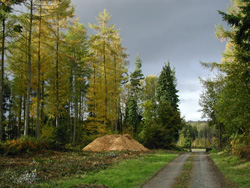 Both commercial forestry and small scale woodland management can produce a range of outputs, including conventional sawn timber, smaller products such as fencing and woodfuel.
Both commercial forestry and small scale woodland management can produce a range of outputs, including conventional sawn timber, smaller products such as fencing and woodfuel.
Often the perception of cutting down trees is entirely negative. Many people who have seen media coverage of deforestation in tropical areas have been left with the understanding that tree felling is a bad thing. While this can be true, the use of woodlands to provide useful timber and other products need not cause environmental degradation and if well managed may result in improvements to the woodland area both for humans and wildlife. The UK forestry industry is highly regulated, and all forestry must be in compliance with The UK Forestry Standard. The woodland area in the UK is currently growing year on year.
The overwhelming majority of countryside in the UK is a result of intensive human interactions with the landscape over many hundreds of years. This is particularly true of woodland, and all woodland in the UK has been managed by humans at some point in its life. This has resulted in a fragmentation of habitat and a fundamental change in how species have adapted to their environment. Prior to human involvement in the management of the natural environment, woodlands covered a significantly higher proportion of the UK. Species were mixed on a large scale and formed a “mosaic” of different woodland habitats caused by large scale interactions between environmental factors such as floods, storms, fires, and droughts. This mosaic would include trees at a variety of ages and species, and areas with standing dead trees as well as open areas of heath, bogs, marshes etc.
Humans have been manipulating the natural environment for a very long time. The Domesday Book shows woodland cover in England at around 15%, and during the 19th Century woodland cover dipped below 5%. Since then woodland area has been increasing, but the UK still has one of the lowest proportions of woodland cover in Europe (currently at around 12%).
Managing a woodland well mimics the mosaic structures of the ancient landscape on a smaller scale providing a wider range of habitats for wildlife species. By carefully selecting, felling, and supporting re-growth of trees we can provide a wide range of benefits for the environment as well as useful timber and social benefits:
The way we manage our woodlands is going to have to evolve as the things we need from woodlands, and the environment they operate in changes. For more information on the necessity for woodland management, see the report from the Independent Panel on Forestry. For more information on climate change and resilient woodlands, see the Forestry Commission England guidance here.
